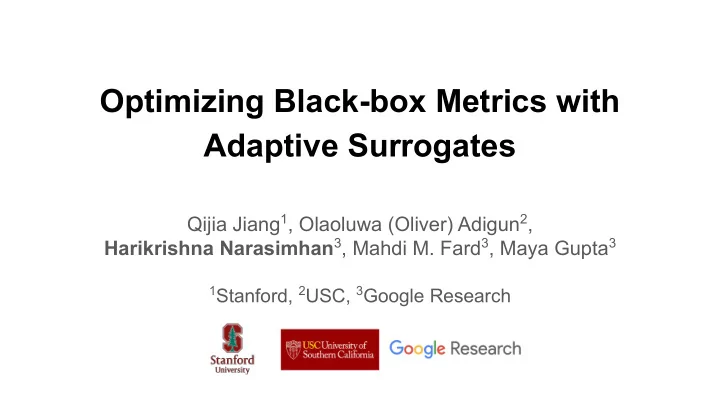

Optimizing Black-box Metrics with Adaptive Surrogates Qijia Jiang 1 , Olaoluwa (Oliver) Adigun 2 , Harikrishna Narasimhan 3 , Mahdi M. Fard 3 , Maya Gupta 3 1 Stanford, 2 USC, 3 Google Research
Misaligned Train-Test Metrics Training objective often mis-aligned with the test evaluation metric Evaluation metric is complex and is difficult to Training data drawn from a different approximate with a smooth loss distribution than the test data Train Test F-measure Prec@ k AUC-PR Recall@ k G-mean NDCG H-mean MAP PRBEP MRR
Blackbox Metric w/ Compositional Structure Common Evaluation Metric Surrogate Losses E.g. F-measure, Precision@K Unknown / Black-box
Classification with Noisy Labels Evaluation metric on true labels (e.g. ratings) Losses on cheap noisy labels (e.g. clicks) (Small validation data) (Training data) Unknown / Black-box
Complex Ranking Metrics Precision@10 Different smooth surrogates for the metric Unknown / Black-box
Main Contributions ● Equivalent optimization problem in lower-dimensional space: Optimization over K-dim surrogate space ● Solve reformulated problem using projected gradient descent with zeroth-order gradient estimates ● We show convergence to a stationary point of M ● Experiments on classification and ranking problems
Related Work ● Optimizing closed-form metrics ○ e.g. Joachims (2005), Kar et al. (2014), Narasimhan et al. (2015), Yan et al. (2018) ● Optimizing black-box metrics ○ Example-weighting (Zhou et al., 2019), Reinforcement learning (Huang et al., 2019), Teacher model (Wu et al., 2018) ○ Limited theoretical guarantees
Related Work ● Optimizing closed-form metrics ○ e.g. Joachims (2005), Kar et al. (2014), Narasimhan et al. (2015), Yan et al. (2018) ● Optimizing black-box metrics ○ Example-weighting (Zhou et al., 2019), Reinforcement learning (Huang et al., 2019), Teacher model (Wu et al., 2018) ○ Limited theoretical guarantees ● This Paper ○ Simple approach to combine a small set of useful surrogates to optimize a metric ○ Directly estimates only the local gradients needed for gradient descent training ○ Rigorous theoretical guarantees
Reformulate as Optimization over Surrogate Space ● Space of achievable surrogate profiles:
Reformulate as Optimization over Surrogate Space ● Space of achievable surrogate profiles: ● Reformulate as a constrained optimization over K-dim surrogate space: ● Lower dim problem as usually θ t Model space Surrogate space (d-dimension) (K-dimension)
Projected Gradient Descent over Surrogate Space ● Apply projected gradient descent to solve reformulated problem ● Challenges: is not known ○ is not explicitly available ○ θ t How do you estimate gradients for ? How do you project onto ? Model space Surrogate space (d-dimension) (K-dimension)
Simplified PGD Algorithm
Simplified PGD Algorithm ● Estimate local gradient for at
Simplified PGD Algorithm ● Estimate local gradient for at Perturb model θ t and compute linear fit from losses to metric ○
Simplified PGD Algorithm ● Estimate local gradient for at Perturb model θ t and compute linear fit from losses to metric ○ ● Gradient update on surrogate profile:
Simplified PGD Algorithm ● Estimate local gradient for at Perturb model θ t and compute linear fit from losses to metric ○ ● Gradient update on surrogate profile: ● Project to set of achievable surrogate profiles
Simplified PGD Algorithm ● Estimate local gradient for at Perturb model θ t and compute linear fit from losses to metric ○ ● Gradient update on surrogate profile: ● Project to set of achievable surrogate profiles : solve a regression problem in θ to match target profile
Convex Projection and Convergence ● Our actual algorithm works with surrogates that are convex ● Even with convex surrogates, is not necessarily a convex set ● So we optimize over a convex superset of the surrogate space ● We show that the projection onto this set can performed inexactly as a convex regression problem in θ (convex)
Convex Projection and Convergence ● Our actual algorithm works with surrogates that are convex ● Even with convex surrogates, is not necessarily a convex set ● So we optimize over a convex superset of the surrogate space ● We show that the projection onto this set can performed inexactly as a convex regression problem in θ ● Guarantee: Converges to a near stationary point of the metric under smoothness/monotonicity assumptions, i.e., (convex) + constant
Classification with Proxy Labels ● Minimize classification error with proxy labels, small validation set with true labels ● Sigmoid losses on the positive and negative examples used as surrogates Dataset Label Proxy LogReg PostShift Proposed Marital Adult Gender 0.333 0.322 0.314 Status Wife Same Same Business 0.340 0.251 0.236 Business Phone No (lower values are better)
F-measure with Noisy Features ● Maximize F-measure with features from one group of examples being noisy, small validation sample with clean features ● Surrogates: hinge loss averaged over either the positive or negative examples, calculated separately for each of the two groups Credit Default dataset Predict if a customer would default Noisy features for male customers (higher values are better)
Ranking with PRBEP ● Maximize Precision-Recall Break-Even Point: ○ Precision at the threshold where precision and recall are equal ● Surrogates: Precision at Recalls 0.25, 0.5, 0.75 Kar et al. (2015) Proposed Train 0.473 0.546 KDD Cup 2008 Dataset Test 0.441 0.480 (higher values are better)
Conclusions ● Optimize a black-box metric by adaptively combining a small set of useful surrogates. ● Proposed method applies projected gradient descent over a surrogate space, and enjoys convergence guarantees. ● Experiments on classification tasks with noisy labels and features, and ranking tasks with complex metrics.
Recommend
More recommend